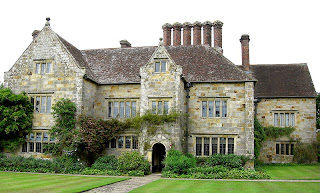Saturday, May 14
Seven miles east of Heathfield is the village of Burwash, the place where Rudyard Kipling lived for thirty four years at the house he called "Batemans". His widow gave the house and thirty-three acres to the National Trust after Kipling's death in 1936.
We toured the house, built in 1634. It is furnished as it was in the early 1900's when Kipling lived there. The grounds are kept in beautiful condition. Ten foot tall hedges in front are kept trimmed so precisely that they look like solid green walls surrounding grass that looks smooth enough to be a putting green.
A formal walk at the back of the house leads past a large, shallow rectangular pond where bright orange goldfish swim in lazy random patterns. The surface of the water reflects nearby trees and the brilliant yellow and deep blue iris that grow along its edges.
Passing through a wrought iron gate in the stone wall at the back of the garden, the path follows the bank of a meandering stream a short distance, crosses a wooden footbridge, and ends at an old gristmill that is also part of the property.
The mill pond and the mill are kept in working order and operated by volunteers, and as we approached we could hear the water splashing onto the mill wheel, which squeaked faintly as it slowly rotated, and the rhythmic rumbling of the wooden gears inside, turning the big stone wheels of the mill. There was a steady quick-marching cadence clack-clacking coming from the second floor as we entered. That turned out to be wooden cams on the drive shaft that operated a lever designed to vibrate the screen where the corn was placed, shaking the individual kernels through and down between the mill wheels at just the right amount to keep everything grinding at the right speed.
The afternoon was cool and sunny, but pleasant enough that we enjoyed hiking several miles through buttercup-filled meadows near Heathfield.

No comments:
Post a Comment